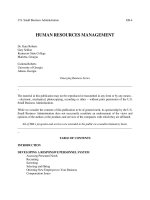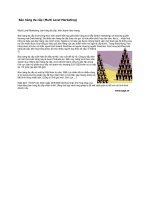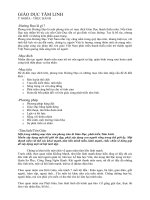Tài liệu E-Human Resource Management 27 pptx
Bạn đang xem bản rút gọn của tài liệu. Xem và tải ngay bản đầy đủ của tài liệu tại đây (680.46 KB, 9 trang )
220 Watson, Schwarz, & Jones
Copyright © 2005, Idea Group Inc. Copying or distributing in print or electronic forms without written
permission of Idea Group Inc. is prohibited.
interesting to note that one group of allied health workers who worked
permanently in one unit rather than moving throughout the hospital (as do
physiotherapists, dieticians, and speech therapists) was more affected by ICT
changes and was not positive about the outcomes.
With respect to RQ2 — communication effectiveness — health professionals
noted that maintaining their perceived levels of communication effectiveness
prior to the change was problematic. Their concern stemmed from the fear that
because of some ICT innovations (e.g., PACS), there was a reduction in face-
to-face communication with other health professionals — a key aspect of
communication for health careers. Thus in this organization maintaining effec-
tive communication did not align well with aspects of the proposed ICT change.
Clearly, employees who control aspects of their work and working conditions
are going to be happier than employees who do not. With relation to our
findings, hospital executives who possessed the macro picture of the change
and monitored the changes were more positive than those staff members who
were confronted with change implementation and new ICTs. Just as clearly,
however, despite the potential of an organizational community through ICTs,
participatory management and empowerment is not an inevitable component of
technology change. Results relating to RQ1 and RQ2 suggested that despite
goals of enhanced performance, there was no redistribution of authority. Thus,
while the hospital executive perceived that there would be staff empowerment
through better ICT systems, this expectation was not realized.
Specific Findings
Workgroup Identity
Social identity theory posits that when change occurs, some employees will
react with perceptions of threat to their in-groups. As a consequence, they will
act to protect their social group status. Thus in-group bias may increase, but the
group may also seek to create a new group identity. If the group does strive to
create a new group identity, then social identity theory would predict a new
energized in-group identity, as was seen in the creation of the “black is
beautiful” new identity in the 1960s for black Americans. When doctors and
allied health professionals spoke about the technology change, they identified
with two in-groups, the hospital (distal in-group) and their profession (proximal
Is Organizational e-Democracy Inevitable? 221
Copyright © 2005, Idea Group Inc. Copying or distributing in print or electronic forms without written
permission of Idea Group Inc. is prohibited.
in-group). When discussing the change implementation in more general terms
(e.g., patient care), however, both their proximal in-group and out-group
salience were more evident, that is, they spoke more about work units and
professional identity. Interestingly, nurses did not make their professional
identity salient when talking about ICT changes — rather they identified with
the more distal in-group of hospital. The reasons underlying this finding are
unclear. In contrast, when nurses talked about other general change issues,
their identity as a nurse and in particular their unit was salient. This point is taken
up below,
Overall, executives identified as being part of the hospital first and foremost.
Doctors talked about how medical professionals (the in-group) felt threatened
by the change process that was being managed by the executive board (the out-
group). For example, at Time 1, a senior doctor commented on a computerized
patient file system that he thought would be phased in at a later stage of the
change:
“I’m not so sure it [the new patient file system] will be a success. I suspect
they’re trying to save on clerical staff and turn us, all the clinicians, into
mini-clerks.” (Participant A, Senior Doctor, Time 1)
This doctor was reporting his perceptions that executives were imposing new
work roles on clinicians. The hospital’s non-executive medical employees
understood that their roles had changed because of the new system’s informa-
tion-sharing or task-related initiatives. They were compelled to adapt to these
role changes as prescribed by the executive level. In the quote, the doctor
stated that his in-group felt threatened as a group by the out-group of
executives. The episode demonstrated the broader principle that rather than
create a new identity, built on ICT-based participatory practice, the strength
of traditionally instituted group affiliation and group status remained in place. A
Level 3 nurse at Time 1 also spoke about the executive as the out-group and
his perception of threat.
“They [the executives] all say we’re cutting back on jobs, but nobody
knows what numbers and to who[m] they’re looking at or who[m] they’re
keeping on. It’s that big question mark that everybody’s a little bit
scared.” (Participant B, Registered Nurse, Time 1)
222 Watson, Schwarz, & Jones
Copyright © 2005, Idea Group Inc. Copying or distributing in print or electronic forms without written
permission of Idea Group Inc. is prohibited.
At Time 2 a different senior doctor commented on the role of the executive and
their power in relation to the government control of the executive.
“Well they [the executives] neither have the given authority nor
management skills. They might acquire the management skills if they were
delegated the authority, but [health state government] is very much rule
and structure, and authority comes from the top down. And any attempts
to give individuals management authority are very rapidly squashed by
reversal of their decisions when they are not liked.” (Participant C, Senior
Doctor, Time 2)
These comments still focused on the executive as the out-group, but this
participant was also viewing the bigger picture of where the executive sat in
terms of their power. The comments again validated the lack of change in
respect to overall structure and democratic process during ICT change.
Effective Communication
Health professionals expressed concern about the effects of new technology on
communication. For example, an allied health professional was of the opinion
that the new PACS technology led to reduced communication between health
professionals, leading to a loss of relationship with other clinicians and trainee
staff. She commented that the medical staff [people] would lose the network
connections that currently existed.
“…new residents may not be super-familiar with the techniques…but by
seeing them face to face, you can say well, look, you know, how you can
determine priorities…the personal [contact] will be lost. People won’t
know who to contact when they really need something in a hurry. It’s just
punching into a screen [ordering using a computer screen]…rather than
coming down and seeing someone and say, ‘Look, what can you do about
it?’” (Participant D, Allied Health Professional, Time 1)
A member of the executive level focused on this reduced level of communica-
tion at Time 2. However, she looked to the level of efficiency that would be
achieved.
Is Organizational e-Democracy Inevitable? 223
Copyright © 2005, Idea Group Inc. Copying or distributing in print or electronic forms without written
permission of Idea Group Inc. is prohibited.
“We have images available throughout the organization at the same time,
but [do] not have to run around with only one person having access at the
one time.” (Participant E, Member of Executive (and doctor), Time 2)
The sentiments regarding the PACS technology expressed by the allied health
professional at Time 1 demonstrated the view of non-executive health profes-
sionals that communication still needed to take place at the physical rather than
the electronic level. Face-to-face communication was viewed as an important
feature of the intra-hospital networking system. A perceived lack of such
communication brought about by the ICT change was therefore viewed as a
threat to communication efficiencies. For example, PACS technology meant
that x-ray requests could now be requested electronically. The old system had
meant that forms were filled out and taken down to the x-ray division. As a
result of the archaic manual system, however, interns got a better understanding
of x-ray procedures and could ask for advice from the radiographers and
radiologists because they interacted with them. As exemplified by the allied
health professional quote at Time 1, ICT change thereby paradoxically allowed
both a reduction in information connectivity alongside an increase in autonomy.
But rather than enable the ease of information sharing, as e-democracy
practices forecast, our results revealed an atrophying of inter-disciplinary
contact and subsequently lower effective communication than previously
existed.
In presenting much the same belief in the need for face-to-face communication,
doctors suggested that PACS changes did not allow important information
relayed by people to be received effectively. A doctor related the medical
professional perspective of the PACS change:
“I think that probably medical staff prefer to communicate in person and
by voice. That’s the way we spend our day talking to people…and we
[doctors] don’t like communicating so much by paper, and yet
administrative staff communicate with us via paper which is seen as
impersonal.” (Participant F, Doctor, Time 1)
This doctor implied that owing to the culture of medical staff (i.e., his in-group),
important information was continuously lost, ignored, or overlooked as the
systems changes started to take effect.
224 Watson, Schwarz, & Jones
Copyright © 2005, Idea Group Inc. Copying or distributing in print or electronic forms without written
permission of Idea Group Inc. is prohibited.
At Time 2 a nurse commented that the structure of the hospital would improve
the communication. His comments supported the notion that health profession-
als recognize the need to communicate on a face-to-face basis. Interestingly,
he also addressed the issue of work identities. While this comment does not
directly address ICT, it highlighted the face-to-face culture that exists in the
hospital context.
“Because of the way the building is laid out, it flows on, there is no defined
point of one ward ending and the next ward starting. A lot of units overlap
each other as well, so it’s going to force communication between them.
That has, I mean, it’s positive in one aspect, but negative in that they don’t
have their own identities as such.” (Participant G, Nurse, Time 2)
Change and Adjustment as an Outcome of Social Identity and
Communication
Workgroup identity and communication work against each other or together to
influence both intergroup and individual adjustment to change. In the hospital
setting described in this chapter, the outcomes were such that the hospital
remained a highly stratified institution. Both executive and non-executive
groupings were able to develop justifications and explanations for the lack of
participatory change and for existent structural arrangements. Specifically,
although some executives expressed concern for lower level staff as they were
experiencing a high workload and stress associated with the changes, they were
simultaneously convinced that there were more positive issues brought about
by the change than there were negative. The system and the processes it set in
place did not bring about an amalgamation of different groups, nor did it
equalize the way authority was transferred. Non-executive groups adopted a
far more reactive outlook to the change, as one doctor states:
“There are some clinicians [who are] very computer literate and very
keen on computers — both in work and recreation. Others like me are not
the slightest bit interested, and that technology’s going to be forced on us,
and I think it’s foolish. I mean we’re not trained and we shouldn’t be paid
to put information into computers and operate computers. We are trained
and should be paid to be skilled clinicians, not computers jockeys.”
(Participant A, Senior Doctor, Time 1)









